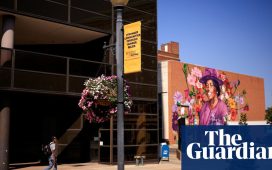Two small inflatable floats with printed aquatic animals in bright colors lay by the river under the Eagle Pass port of entry in Texas on Saturday, a day after nine migrants died while swimming the Rio Grande.
A parent had placed their child in the floats and jumped in a river that looked deceptively calm. National guardsmen tasked with watching that section of Eagle Pass saw it for what it was: a treacherous, deep body of water with whirlpools between pillars holding up the international bridge.
“That’s the problem with people from other countries,” said Tom Schmerber, the Maverick county sheriff. “When they come, they’re used to seeing big rivers. Then they see this one. It’s not too big for them. But the Rio Grande carries a lot of currents.”
Deaths in the river became commonplace this year, after a migration shift pushed thousands here.
“Almost every single day we respond to the river and recover at least one body a day,” said Manuel Mello, the Eagle Pass fire chief. “Some days you won’t recover for two or three days. [But] Monday or Tuesday we recovered four bodies with the Border Patrol.”
Mello estimates about 30 bodies have been taken from the river each month since March.
Migrant encounters, rescues and recidivism rates increased dramatically when Title 42, a public health policy barring migrants from seeking asylum, went into place in the Covid pandemic.
Locals said rains over the last two weeks dumped more water into the river, which had been in drought, adding to its volatility.
Many migrants cross dangerous terrain like the infamous Darien Gap in southern Panama or other perilous routes.
Jhoana Contreras, a 33-year-old Venezuelan mother of three who made it to Eagle Pass after border patrol released her and sent her to Mission: Border Hope, a welcome center in Eagle Pass helping guide migrants through their journeys into the US.
“I didn’t think it would ever end,” she said of the journey, adding, “because it took days, days and days, rivers, rivers and rivers”.
Contreras broke down as she recounted other times she, her husband and brother nearly lost it all.
“We were kidnapped in Guatemala. We went through things we never imagined we’d go through. I thank God who always kept us safe.”
Contreras and family members crossed into the US via the Rio Grande, or Rio Bravo as it’s known in Mexico, for its wild nature. At one point, she said, she went under the water and was rescued by her husband.
She was one of the lucky ones.

On Saturday, dozens of migrants were dropped off and picked up from Mission: Border Hope. Parents shuffled down charter buses with children in their arms. Some children were fast asleep. Others were wide awake.
Contreras’ children were not with her.
“I wouldn’t want the experience that so many children had on the way,” she said. “I saw some children who would faint. They needed food, water, and medicine.”
Her mother is watching them while Contreras and her husband work to get permission to bring them to the US.
Some parents, like Andrés Lecuna, a 39-year-old Venezuelan father of a five-year-old girl, brought their families in spite of the danger.
“It’s something I lived through myself, because my daughter and wife nearly drowned. Some people we were traveling with helped save them,” Lecuna said. “My arms were giving out, because the current was too strong. I felt I was drowning.”
Lecuna’s daughter, who wore a pink shirt and braids made by her mother, played with rocks outside the welcome center as her father contemplated the fate of those who died Friday in the same waters.
“I was surprised, because some of those who died were people traveling with us. A mother of an autistic son died. She was traveling with her husband and a daughter,” Lecuna said.
The Guardian was not able to verify his account.
He said other men went under, men who knew how to swim like he did.
“I went under with my feet touching the ground and the top of my head wouldn’t even touch the surface,” he said. He calculated the depth was between 6ft and 9ft. “You get a cramp. Your arms get tired. You go into shock.”
Migrants often travel in groups, to help each other through tough spots.
“If we come together, we cross together,” said Jorge Luis Acosta, a 34-year-old single man from Cuba in Eagle Pass. “It was a bit dangerous, because it was deep. We were keeping watch over women and children so nothing bad would happen to them.”
The last two years have seen record-breaking numbers of people attempting to cross the border illegally. The border patrol sector that includes Eagle Pass has seen almost as many migrants this year as the Rio Grande Valley sector, the traditional route of entry. The Eagle Pass region has seen about 376,000 encounters, while the Valley had nearly 413,000. Many tried to get in more than once.
Recidivism rates increased from 14% in 2015 to 26% and 27% in the last two years.
As desperation grows, more people are willing to risk their lives. From 2019 to 2022, rescues nearly tripled, with a 284% increase, according to US government data. The change started last year, up to nearly 13,000 from about 5,000 in 2020.
“You have females drowning. We found some who were pregnant. Their kids drown. It’s not only just them, but families,” Sheriff Schmerber said.
For many, the risk seems worth it.
“It’s not easy to go through so much adversity, but it’s worth it because I believe in the American dream,” said Lecuna, who traveled with his wife and daughter.
Acosta said: “They’re people just like you. People who are looking for a better life: a better economy, a way to feed, clothe and educate their children. That’s all they want.”








